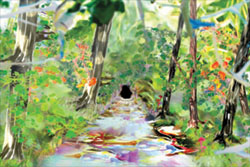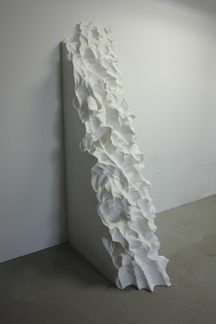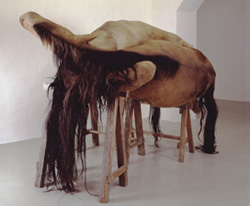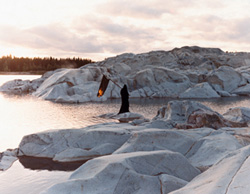
|
||
|
Portland art blog + news + exhibition reviews + galleries + contemporary northwest art
|
||
Report from Tacoma: Fresh at Museum of Glass
The artists in Fresh employ allegory in a distinctly postmodern way. Drawing from Craig Owen's essay on The Allegorical Impulse, curator Juli Cho Bailer identifies appropriation, impermanence, accumulation and hybridization among these strategies. For the artists in Fresh, the use of allegory implies much more than a means of creating symbolism. Allegory becomes a multi-layered way of describing contemporary life, in which everyday experience is oftentimes mediated through technology and nature is tempered by human intervention. At the same time, many of these artists use allegory to explore the personal through more universal thematics. Gordon Cheung's painting, Rented Reality, portrays a somewhat adolescent vision for a dystopian future. Rows of numbers collaged from the pages of the Financial Times serve as a backdrop for high rise buildings that emerge from the desert landscape. The entire scene wavers queasily, as if caught between nature and civilization, rationality and the druggy irrationality implied by the hallucinogenic colors of the sky. Though global market forces are rendered as an abstracted flow of numerical data, they hold as much reality-altering potential as substances. Takagi Masakatsu and Saeko Takagi present a much cheerier, though no less psychedelic, vision of nature in their short animation of hand-drawn cells, Color of Empty Sky. The imagery is personal and fantastical, showing an ever-morphing, dream-like landscape saturated with intense color, populated by cute animals and accompanied by a sugary soundtrack featuring Japanese pop star UA. In contrast, Marc Swanson's black-clad diorama of deer in a charred forest denies us this lushness, but, like Masakatsu and Takagi's video, hints at the cyclical process of renewal. Joyce Korotkin's work implies distrust of the disconnect between mediated and real experience. As part of a series of monochrome paintings depicting nondescript views of urban parks, her painting possesses a disarming neutrality that defies the more sinister title that accompanies it. Through its suggestive title, Incidents & Allegations I transforms an idyllic—though presumably man-made—landscape into a potential crime scene.
Angelo Filomeno's two taxidermied peacocks do not elicit the same kind of visceral response. Instead, they are embedded within a formalized configuration that attests to Filomeno's predilection for Baroque indulgence. Spewing chains of red crystals, death becomes symbolized through ornamentation. In Shitting Baroque (Death Moth), one of Filomeno's lavish hand-embroidered works, the wings of a black moth morph into grimacing skulls, the opulence of the material construction contrasting with the morbid iconography. Whereas Bruyckere and Filomeno rely on a certain gravity to carry the conceptual content of their work, Hanna Liden eagerly embraces the pop-culture origins of her photographs. Situated squarely within the output of young artists like Olaf Breuning, Naomi Fisher and Banks Violette, Liden's work is beautifully executed but utterly shallow. These photos—in which costumed and masked characters engage in ambiguous ritualistic behavior—seem to be concerned with little more than acting out neo-tribalist and Goth-culture-inspired fantasies. Here, nature is used as a set and allegory as a way to literally mask meaning.
Posted by Katherine Bovee on August 18, 2006 at 1:38 | Comments (0) Comments Post a comment Thanks for signing in, . Now you can comment. (sign out)
(If you haven't left a comment here before, you may need to be approved by
the site owner before your comment will appear. Until then, it won't appear
on the entry. Thanks for waiting.)
|
| s p o n s o r s |
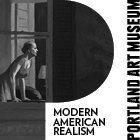 |
 |
 |
 |
 |
 |
 |
 |
 |
 |
 |
 |
 |
 |

|
Site Design: Jennifer Armbrust | • | Site Development: Philippe Blanc & Katherine Bovee | |


